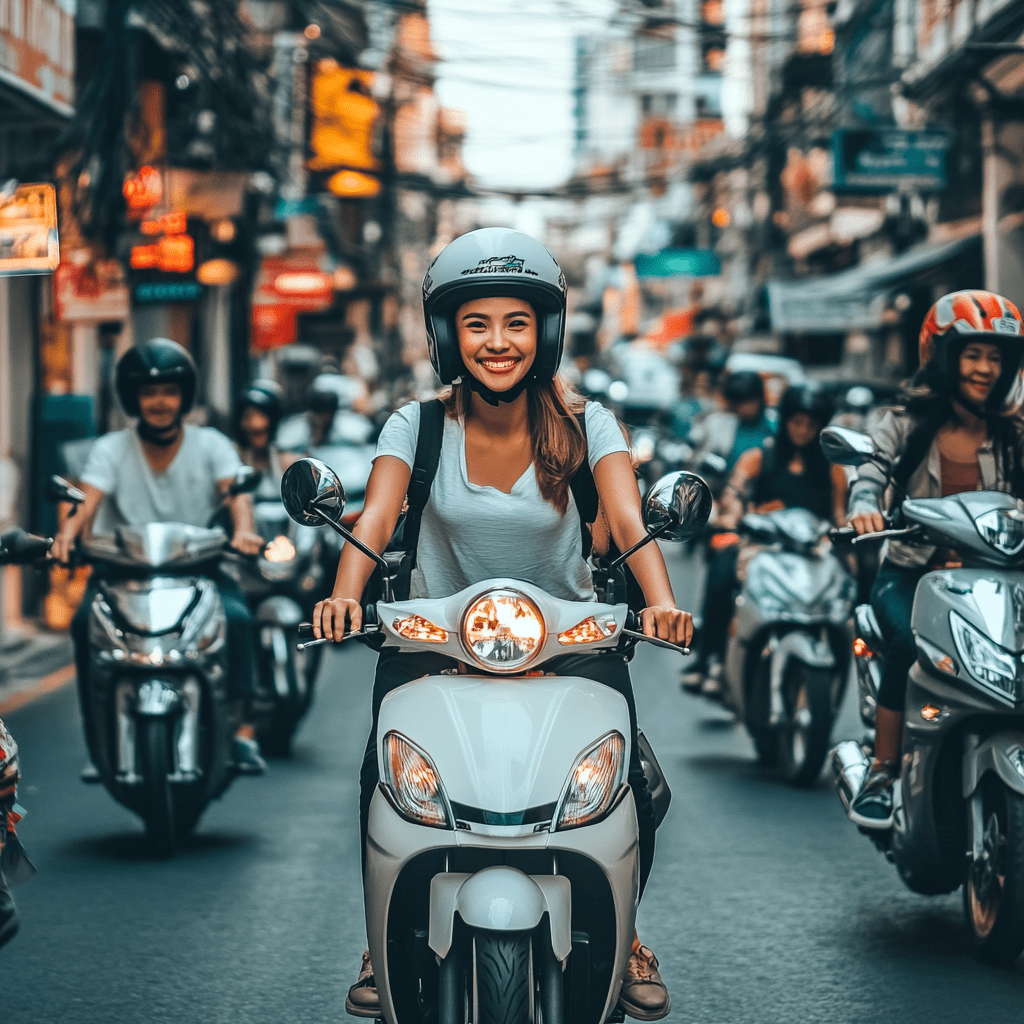Bangkok can feel overwhelming at first sight—traffic everywhere, streets alive 24 hours a day, food stalls glowing in every direction. Yet beneath that chaos lies one simple truth: the fastest, cheapest, and most exciting way to experience the city is on two wheels. Anyone planning to rent motorcycle in Bangkok will quickly realize that scooters are not just a convenience—they are the heartbeat of the city.
Every visitor notices them before they even leave the airport: endless rows of brightly colored scooters zipping past taxis, carrying office workers, students, monks, and delivery drivers. With public transport covering only limited corridors, the motorcycle has become Bangkok’s unofficial taxi. Renting one gives freedom that buses and Skytrain lines can’t provide.
Still, the process can confuse newcomers. Prices vary wildly, rules seem inconsistent, and many small shops operate without clear contracts. This guide explains everything—how to find legitimate rentals, what licenses you actually need, how police checkpoints work, where you can legally park, and why modern services such as RentLab are changing the entire experience for the better.
Why Rent a Scooter in Bangkok
Bangkok traffic has a reputation for being chaotic, but in reality, it’s organized chaos. Once you learn the rhythm, it becomes manageable. A scooter lets you slide through congestion, park almost anywhere, and explore neighborhoods tourists rarely reach—places like Ari’s café lanes, the canals of Phasi Charoen, or the sunset river bends near Rama VIII Bridge.
Taxis often refuse short rides or overcharge during rainstorms. GrabBike and Bolt are good for one-off trips, but if you’re staying longer than a few days, renting is cheaper and more flexible. Daily scooter rental Bangkok prices usually start around 200–250 THB for smaller models such as Honda Scoopy or Click 125i, and 300–450 THB for mid-range Yamaha Aerox or Grand Filano. Long-term motorbike rental Bangkok deals drop the rate dramatically—sometimes under 3 000 THB per month for reliable automatic bikes.
Choosing the Right Bike for Your Trip
Not all scooters are equal. Here’s how to match model to purpose:
- Honda Scoopy / Fino / Click 125i – Light, perfect for city hops, good fuel economy.
- Yamaha Aerox 155 / Grand Filano – Sportier handling and more comfort for two people.
- Yamaha NMAX / GPX Drone – Larger frame, excellent for expressways and long-distance weekend rides to Pattaya or Ayutthaya.
Tourists often underestimate the importance of seat comfort and storage. Bangkok days are long; carrying a backpack on your shoulders in 35 °C heat isn’t fun. A scooter with under-seat space saves energy. RentLab’s fleet focuses on these practical details, keeping bikes that fit typical traveler needs rather than random leftovers many local shops offer.
Legal Requirements: Licenses and Helmets
Thailand’s traffic laws are strict on paper, though enforcement can vary. For tourists, the key points are simple:
- You must hold an international driving permit (IDP) that covers motorcycles.
A car-only permit is not enough. Police checkpoints frequently target tourist areas—Asoke, Sukhumvit 22, Ratchada, and Bang Lamphu—and fines for riding without a valid license are about 500 THB.
- Helmet laws apply to both rider and passenger.
Wearing helmets is not optional, and police can fine each person separately. RentLab and most reputable agencies provide helmets included in the price.
- Third-party insurance is mandatory; full damage coverage is optional but recommended.
- Traffic direction: drive on the left side, keep right for overtaking, watch for U-turn lanes which appear often and suddenly.
Following these basics avoids 90 % of tourist problems.
Police Checkpoints and Fines
Bangkok’s police checkpoints are routine, especially during morning and evening rush hours. They aren’t meant to intimidate; they’re mainly for licenses, helmets, and sometimes alcohol testing. Always slow down, smile, and show your documents. Keep your passport copy or photo on your phone—never carry the original while riding. If fined, pay the official ticket at the nearest police station or mobile booth; avoid paying cash directly on the street unless it’s a clearly marked checkpoint fine.
Tourists sometimes panic when stopped, but as long as you stay polite and show an international license, officers usually wave you through. Digital rental companies like RentLab include printable license and insurance summaries in English and Thai, which speeds up communication.
Navigating Bangkok Like a Local
The trick to surviving Bangkok traffic is rhythm. Locals flow rather than fight.
A few real-world tips:
- Watch intersections: right-turn lanes are unpredictable. Follow scooters ahead instead of trusting lane arrows.
- Avoid peak hours around 7–9 AM and 4:30–7 PM on Sukhumvit Road; even scooters get boxed in.
- Learn short-cuts (sois). Google Maps shows them, but not all are scooter-friendly; RentLab’s local guide marks verified safe shortcuts for renters.
- Rainy-season riding: tropical rain hits fast; always carry a lightweight poncho. Bangkok drains quickly, but road paint gets slippery.
- Parking: at malls and BTS stations, scooter parking costs 5–20 THB; avoid sidewalks with red-white paint, which means “no parking.”
By your second day, you’ll already be moving like you were born here.
Tourist Traps and Common Scams
The vast majority of rental shops are honest, but a few old scams still survive. Avoid them easily:
- Passport hold – never leave your passport. A digital ID scan or deposit is enough.
- Scratch fee trap – take photos of the bike from every angle before riding.
- Fuel confusion – check if “full tank” is really full; top up yourself at PTT or Shell station nearby.
- Flat tire claim – verify tire condition before accepting.
Modern companies like RentLab eliminated these problems through automated check-in photos and timestamped condition reports. You get transparency without confrontation.
Understanding Real Costs
Renting a scooter in Bangkok seems cheap until small expenses add up.
Typical daily costs:
- Fuel: 40–60 THB for 3 liters ≈ 70 km.
- Parking: 10–20 THB average per stop.
- Fines or tolls: usually none if you follow rules.
- Maintenance: covered by rental company.
Even with extras, total daily transport cost rarely exceeds 300 THB, far cheaper than taxis or ride-shares for multiple trips. Long-term renters save the most—RentLab’s monthly rates often undercut cumulative GrabBike expenses by 60 %.
Where to Ride: Exploring Bangkok on Two Wheels
- Old Town (Rattanakosin) – ride early morning through temples like Wat Pho and Grand Palace; parking is easy before 8 AM.
- Ari & Phaya Thai – modern cafés, quiet sois, perfect afternoon ride.
- Chinatown (Yaowarat) – go at night; park near Odeon Circle, walk the food street.
- Rama IX Park & Suan Luang – green escape; locals jog and picnic.
- Bang Kachao – nicknamed “Bangkok’s green lung,” accessible by ferry with scooter; lush trails and coffee stands.
Bangkok’s beauty isn’t only in temples and malls—it’s in the feeling of discovering a street you didn’t plan to enter.
Short-Term vs Long-Term Rentals
For visits under a week, daily rates make sense. For stays over ten days, monthly rentals save a fortune.
Short-term rentals focus on flexibility: walk-in, cash, minimal paperwork. Long-term deals add stability—scheduled maintenance, replacement bikes, and digital receipts. RentLab’s system makes extensions seamless: a few taps and your rental continues automatically without returning to the shop.
Digital long-term subscriptions are becoming the new standard among digital nomads and expats who work from Bangkok cafés or co-working hubs. Paying monthly also improves accountability; both sides know the arrangement is ongoing, not a one-off transaction.
Fuel, Maintenance, and Emergency Support
Gas stations are everywhere, open 24 hours. Use 91 or 95 gasoline (green pump heads). Never pour bottled roadside fuel unless you’re stranded. Keep tires inflated—many shops check free of charge.
If the scooter breaks down, call the rental’s hotline. RentLab operates bilingual 24 / 7 support with pickup vans; many small shops do not. Carry a paper copy of the hotline number in case your phone dies.
Insurance and Accident Procedure
Accidents are rare if you ride defensively, but always know what to do:
- Don’t move the bike immediately unless blocking traffic.
- Take photos of the scene and plate numbers.
- Call your rental provider—RentLab dispatches assistance automatically when you report via app.
- For minor cases, Thai police handle on site; for injuries, go directly to hospital and call insurer later.
Having English-language documentation makes the difference between chaos and calm. Choose companies that provide it in advance.
Cultural Etiquette While Riding
Thai traffic has unwritten rules. Respecting them keeps everyone happy:
- Use horn softly to alert, not to scold.
- Give way to pedestrians even if lights favor you.
- Don’t weave aggressively around monks or students in uniforms; culturally disrespectful.
- Avoid revving loudly near temples or residential sois at night.
Motorcycling here is not just transport; it’s participation in a shared rhythm of tolerance and patience.
Why Modern Rentals Like RentLab Are Winning
Older rentals still operate on trust and convenience, but the next wave is digital. RentLab integrates online booking, automated verification, and self-pickup lockers. The main benefits for travelers:
- No passport deposit
- Transparent prices and insurance
- New, well-maintained fleet
- 24-hour pickup availability
- English and Thai support
That combination makes travel simpler. Instead of bargaining on the sidewalk, you arrive, unlock, ride, and explore.
Day Trips Outside Bangkok
Once confident, riders can explore nearby provinces easily within a day:
- Ayutthaya (80 km) – ancient temples, highway 32, scenic and safe.
- Nakhon Pathom (50 km) – Thailand’s tallest stupa, great local food.
- Bang Saen Beach (90 km) – closest beach to Bangkok; pleasant coastal route.
- Pathum Thani & Nonthaburi – riverside cafés, peaceful farmland.
Check your rental contract before leaving the province; most allow it if you notify in advance. RentLab’s GPS coverage and insurance already include neighboring provinces, giving more freedom than typical city-only contracts.
Safety Checklist Before Riding Away
- Brakes firm and symmetrical
- Lights and indicators working
- Tires with visible tread
- Registration sticker current
- Helmet strap secure
Spend five minutes checking; it can save hours later.
Understanding Thai Fuel Stations
Large brands—PTT, Shell, Esso, Bangchak—dominate Bangkok. Prices are government-regulated; you’ll pay similar everywhere. Staff fill the tank for you, so say the amount or “เต็มถัง tem-tang” (full tank). Payment accepted by cash or card. Always ask for receipt if renting long-term; it helps track fuel economy.
Riding in the Rain: The Real Test
Rain changes Bangkok’s behavior instantly. Roads flood fast but drain quickly. Underpasses collect water; avoid them after heavy storms. Brake gently—water reduces friction. Keep headlights on and speed moderate. Carry waterproof bag for phone and documents. Most scooters handle rain fine, but visibility drops fast. RentLab provides free rain ponchos to long-term users—a small but appreciated touch.
Tips for Couples Riding Together
Two-up riding is common, but balance matters.
Passenger should hold side handle, not rider’s waist, to keep airflow stable. Adjust mirrors before departure; with two people, rear angle changes. Avoid hard braking; Bangkok drivers tailgate closely. Communication helps—light taps for slowing, shoulders for turns.
How Long Does It Take to Learn?
If you’ve never ridden before, practice in quiet sois near On Nut or Udom Suk before entering main roads. Automatic scooters are intuitive—twist and go. Within 30 minutes, most people feel comfortable. Still, treat it seriously: Bangkok traffic demands focus. Even experienced riders need a day to adjust to left-side driving.
When to Return or Extend
Return time flexibility depends on provider. Small shops often close early, and late return fees appear easily. RentLab’s system timestamps the moment you drop keys in locker, so there’s no debate. If you want to extend, online payment updates automatically; no need to visit physical office. That convenience becomes vital for remote workers who manage time tightly.
How Rental Businesses Differ Across Districts
- Sukhumvit & Asoke: tourist prices, English speakers, wide range of models.
- Phra Khanong & On Nut: mid-range pricing, good long-term deals, popular among expats.
- Ratchada & Lat Phrao: local rates, limited English, but cheaper monthly options.
- Silom & Sathorn: focus on short-term business travelers.
RentLab’s centralized system covers all these districts under one booking interface, so you don’t need to chase separate deals.
Seasonal Variations in Rental Demand
High season (November–March) brings European tourists escaping winter—rental prices rise 10–15 %. April’s Songkran holiday adds chaos and water fights; best avoided for first-time riders. The rainy months (June–October) offer discounts and quieter roads. Planning around these cycles saves money and stress.
Parking Rules and Etiquette
Scooter parking is flexible but not unlimited.
Look for blue-signed motorcycle zones or mall basements. Never park blocking sidewalks or police boxes. At night, avoid leaving bikes on dark sois; use lighted areas or your accommodation’s parking lot. RentLab provides digital map overlays of verified parking spots near BTS stations and tourist attractions—a simple feature that saves hundreds of baht in fines.
Understanding Local Communication
Thai people appreciate basic effort: say “khop khun khrap/ka” (thank you) when returning bikes or getting help. Smiling and being patient often gets you free advice or discounts. If you don’t speak Thai, translation apps work fine; keep sentences short and clear.
Why Renting Beats Buying for Visitors
Some long-term expats consider buying used scooters. But ownership brings hidden costs—registration, annual tax, insurance renewals, repairs. Selling later is troublesome. Renting remains simpler, especially when modern systems offer near-ownership reliability. RentLab’s multi-month packages bridge this gap perfectly: you ride like it’s your own, but skip bureaucracy.
Bangkok rewards riders who understand its rhythm. Once you adapt, you start seeing how the city actually works — the unspoken logic behind the apparent chaos. In this part, we’ll look deeper into daily riding culture, advanced safety, long-term accommodation tips for those who rent scooters for weeks or months, and how platforms like RentLab quietly shaped a more tourist-friendly era for motorcycle rentals.
Daily Life on a Scooter: What Tourists Discover
The first week riding in Bangkok changes how you see the city. You notice micro-patterns locals take for granted: motorbike taxis lined in orange vests, shortcuts through temple grounds, 7-Elevens every 100 meters that double as navigation landmarks. Riding transforms the experience from sightseeing to participation. You’re no longer a passenger; you’re part of the organism that makes Bangkok pulse.
Morning commutes reveal how organized chaos really is. Thousands of scooters flow together like a living river — unspoken cooperation instead of competition. The moment you join it, you feel the city’s intelligence. Bangkok drivers are assertive but rarely aggressive; horns are signals, not insults.
At night, it’s another world. The air cools, neon reflections cover the streets, and the sound of engines mixes with street food sizzling. It’s addictive. This is why so many foreigners who once visited Bangkok for a week end up staying for months. The scooter gives them mobility, identity, and independence in a megacity that never sleeps.
Advanced Safety for Busy Streets
Even confident riders need new habits here. Traffic flows left-side, but what matters more are the local unwritten rules:
- Be visible, not fast. Scooters dominate lanes, but cars still hold priority in Thai road psychology. Use your lights even during the day.
- Mirror checks every few seconds. Bangkok drivers use side mirrors mostly as decoration; you’ll avoid surprises by watching them for both of you.
- Stay off bus lanes unless other scooters are doing the same; some are camera-enforced with fines up to 1,000 THB.
- Avoid sudden stops. Delivery riders tailgate closely. Slow down gradually and signal clearly.
- Never assume green means safe. Intersections have lagging red lights; wait one second before moving.
Motorcycle rental Bangkok companies like RentLab conduct regular checks on brakes, tires, and lights. It’s smart to ride new, well-maintained bikes rather than old, wobbly ones that amplify risk. In heavy rain, slow to 30–40 km/h; locals ride confidently, but they’ve done it for years. Tourists don’t need to prove anything — safety is smarter than pride.
Long-Term Life with a Scooter
For visitors staying beyond a few weeks, the scooter becomes an everyday companion. You learn small optimizations — where to park near your condo, which gas stations give free air checks, which sois are shortcuts to skip traffic.
Living long-term with a bike also changes how you choose accommodation. Apartments around On Nut, Phra Khanong, or Lat Phrao offer easy parking and quick access to main arteries. Sukhumvit condos are convenient but charge more for parking. Some hostels don’t allow overnight scooter storage, so confirm before booking.
RentLab’s long-term users often share feedback that access to secure parking was a decisive factor. The company now maps suggested condos and Airbnbs with motorbike-friendly facilities. It’s an example of how data from real users can shape better travel infrastructure.
Hidden Rules of Parking
Bangkok’s parking culture can be confusing until you decode it. Red-and-white painted curbs mean “no parking”; yellow-white stripes often mean short-stay loading zones. When in doubt, follow local scooters — if they park there, it’s probably fine.
Public markets and hospitals often have designated motorbike lots, sometimes free. Shopping malls charge hourly, but prices are symbolic: 10–20 THB per visit. Always take a ticket even if the attendant waves you through — without it, you might face confusion later when leaving.
RentLab’s app includes pinned safe parking points near popular destinations like Terminal 21, MBK, or Chatuchak, so travelers avoid guessing. Tourists frequently waste time circling because navigation apps don’t show dedicated motorbike lots. Having that local knowledge integrated into the rental platform saves stress and fuel.
The Unseen Challenges of Traditional Rentals
Old-school rental shops still line the tourist districts. Some are honest, some careless, a few problematic. Common issues appear repeatedly in travel forums: unclear contracts, unexpected charges for scratches, or difficulties communicating damage reports in English.
These experiences pushed the demand for digital transformation. When tourists post complaints online, Google algorithmically lowers trust scores for those shops. That’s how the market cleans itself. Platforms like RentLab simply built technology around what tourists already wanted — proof, convenience, and reliability.
Their digital check-in process uses timestamped photos before and after each rental. If scratches exist, they’re documented. The system removes the potential for conflict. You return the scooter, drop keys in a secure box, and receive confirmation by email. No debate, no emotional tension, no risk of losing a passport or deposit.
Cultural Adaptation for Riders
Every culture treats motorcycles differently. In Bangkok, scooters are family tools — mothers ride with children, monks travel to temples, office workers commute in suits. Understanding that helps visitors behave appropriately.
Don’t rev loudly near schools or temples; Thais associate noise with arrogance. Don’t block sidewalks during prayers or ceremonies. Keep helmets on your handlebar, not on the ground, as many Thais consider the head the highest part of the body, symbolically sacred.
This respect earns smiles and kindness, which in Thailand often translates to unexpected help — an extra parking space, a discount on fuel, a free air refill. Good manners have practical rewards here.
Bangkok Districts: Matching Lifestyle and Scooter Use
Each part of the city offers a different experience for riders.
- Sukhumvit (Asoke to Ekkamai): best for nightlife and central convenience; heavy traffic but easy parking behind malls and condos.
- Phra Khanong to On Nut: balanced between local life and expat amenities, wide sois, perfect for first-time riders.
- Ari and Phaya Thai: quieter, trendy cafés, less police presence, ideal for long-term living.
- Silom and Sathorn: business zones; roads packed during weekdays but empty on weekends.
- Lat Phrao, Ratchada: local pricing, authentic Thai atmosphere, great for monthly rentals.
Tourists who book via RentLab often pick bikes depending on where they stay. The company’s analytics showed Yamaha Aerox models dominate Sukhumvit, while Click 125 and Filano are favorites in On Nut and Ari due to easier parking in narrow sois.
Long-Distance Trips: What to Know Before Leaving Bangkok
Many riders extend their adventure beyond city limits — to Ayutthaya, Kanchanaburi, or Pattaya. Before heading out, check your rental policy. Most companies restrict rentals within Bangkok Metropolitan Area. RentLab explicitly allows neighboring provinces with active insurance, making weekend trips possible without extra paperwork.
Remember Thai roads can be fast and direct. Highways have separate motorcycle lanes, sometimes narrow but efficient. Avoid riding on full expressways; motorcycles are prohibited. Instead, use parallel roads or “frontage” lanes. Always refuel before rural stretches — petrol stations become rarer once you leave urban zones.
Fuel Economy and Real Expenses Over Time
Scooters are astonishingly efficient. Even powerful 155 cc models average 40 km per liter. A week of city commuting rarely exceeds 250 THB in fuel. Long-term renters often track fuel to measure efficiency; RentLab’s dashboard automatically calculates it from digital receipts uploaded by users.
For tourists on budget stays, this difference matters. A taxi to and from Sukhumvit to Chatuchak costs 300–350 THB round-trip. The same trip on scooter costs around 25 THB in gasoline. The savings accumulate quickly, making motorcycle rental one of the smartest financial choices in Bangkok travel.
Real Experiences: Riders’ Perspective
Interviews with foreign riders reveal a consistent pattern: initial hesitation, followed by enthusiasm.
An Australian traveler described the change like this: “At first, I thought renting a motorbike was risky. But after one day, I realized Bangkok makes sense only when you can move freely.”
A digital nomad from Germany mentioned using RentLab for three months: “I extended my rental three times. I never needed to visit the office once. It felt like having my own bike with none of the ownership hassle.”
Such stories echo across online communities. Tourists want control, not complications. The companies providing that are the ones dominating Google Maps ratings.
Common Mistakes Tourists Make
- Riding barefoot or in flip-flops. It’s legal but unsafe; a small fall can ruin your trip.
- Forgetting to lock handlebars. Theft is rare but opportunistic. Always lock and park under CCTV.
- Using phone for navigation without mount. Police may fine for distracted riding.
- Crossing into restricted lanes. Especially near airports; some are bus-only.
- Ignoring heat. Dehydration sneaks up fast; carry water always.
Bangkok rewards cautious confidence. Enjoy freedom, but respect rhythm.
Comparing Digital Rentals with Street Shops: The Traveler’s View
The choice comes down to comfort vs. chance. Traditional shops are fine if you speak Thai and enjoy bargaining. But most foreigners prefer predictability. RentLab operates like a professional car rental but scaled to scooters. Everything happens online, from ID upload to card authorization.
Tourists appreciate transparency. Prices show inclusive taxes and insurance; no surprises upon return. The self-pickup system solves time-zone problems — you don’t depend on shop hours. And perhaps most importantly, communication is bilingual. For many travelers, the stress of misunderstanding vanishes instantly.
Even Thai locals now rent digitally because they value reliability over small discounts. That’s the direction tourism everywhere is moving — from negotiation-based to system-based experiences.
Technology Behind the Experience
Under the hood, platforms like RentLab combine several technologies: GPS tracking, automatic maintenance reminders, and cloud-based verification. These tools serve not just convenience but safety and accountability.
When a bike approaches service threshold, the system automatically flags it. When a user reports a problem, the support team sees the exact location in real time. This proactive approach means you rarely experience breakdowns. It also builds a track record of reliability, which helps the platform rank higher in both Google and customer trust.
For users, all this happens invisibly. You just enjoy a clean, smooth, insured ride that starts every time. That’s technology done right — invisible, functional, and reliable.
How to Prepare Before Arriving in Bangkok
Book early during high season (November to February). Upload your ID and international license in advance if using digital systems like RentLab — that way your bike waits ready. Save local SIM or eSIM for data navigation; Google Maps and Grab both require stable connection. Bring a small rain jacket, sunglasses, and a copy of your travel insurance.
Most travelers underestimate Bangkok’s sun more than its traffic. UV levels are extreme; wear light long sleeves. Hydration and patience keep you safe longer than any speed.
Why Tourists Rate Scooter Rentals Higher Than Car Rentals
Parking space defines Bangkok. Cars are luxury, scooters are logic. Even high-income locals keep scooters for daily tasks because they reach anywhere and skip congestion. Visitors quickly learn that renting a car creates more limitation than freedom. Scooters combine accessibility, fun, and affordability in one package.
Car rentals face endless issues — deposits, traffic jams, tolls, and limited parking. Motorcycles face only the learning curve. Once you adjust, the city opens.
Digital Integration with Tourism
Modern travel merges mobility and accommodation. Many Airbnb hosts now recommend scooter rental Bangkok links directly in welcome messages. RentLab partners with such hosts, integrating booking forms so guests can reserve before arrival.
This integration simplifies planning for both sides — renters know who to contact, hosts avoid responsibility. It’s a small but powerful example of digital synergy that improves the city’s tourism infrastructure from within.
Evening and Night Riding
Bangkok after dark is peaceful in its own wild way. Traffic thins after 10 p.m., and city lights turn every road into a cinematic ride. Tourists often explore riverside zones like Rama III or the bridges near IconSiam for panoramic views.
Night riding requires extra caution — watch for stray dogs, occasional potholes, and tuk-tuks cutting lanes. Keep visor clean; humidity fogs up helmets fast. Always carry small cash; fuel stations may close payment systems late.
Riding at night is when Bangkok feels infinite — the skyline, music, smells, and warm air make the experience unforgettable.
Respecting the System
The biggest mistake some riders make is assuming Thai rules don’t apply because enforcement is flexible. That attitude ruins tourism reputations. Bangkok police are generally polite and fair if you’re honest. Pay official fines, don’t argue, and keep documents handy. You represent more than yourself when riding abroad.
RentLab encourages responsible riding through safety tutorials and short in-app guides. Educated riders mean fewer accidents, which benefits everyone — from hospitals to other road users. Respect builds reputation, and reputation keeps tourism strong.
Future of Motorcycle Rental in Bangkok
The trend is clear: automation, safety, sustainability. RentLab’s system is ready for electric fleets and app-based expansion. Soon, renting will take less than two minutes. For travelers, that means freedom without paperwork.
As Bangkok modernizes, these platforms won’t just compete — they’ll collaborate with government mobility programs, tourism boards, and smart-city projects. The result will be cleaner, more organized roads and a smoother experience for millions of visitors every year.
Riding a scooter in Bangkok is more than transportation — it’s participation in the city’s heartbeat. The last part of this guide focuses on planning your trip smartly, understanding seasonal differences, how to combine accommodation with long-term rentals, and what the future holds for electric mobility.
Step-by-Step Guide for First-Time Renters
- Choose a reputable source.
Avoid street corners with no signage or official contact. Use verified websites or modern platforms such as RentLab that publish full company details and online reviews.
- Book before arrival.
During high season, scooters in central districts often sell out. Early booking locks both price and model. RentLab’s online form confirms instantly and accepts international cards, avoiding currency exchange hassle.
- Prepare your license and IDP.
Print copies or digital photos. Officers appreciate visible effort; it shows respect for the law.
- Inspect before riding.
Check lights, brakes, mirrors, and tires. Take photos. Even professional rentals encourage it.
- Understand payment and deposit.
Reputable services use small deposits or none at all with digital verification. Avoid shops demanding passports.
- Know the return process.
Confirm drop-off location and time flexibility. Digital systems automatically record return time; manual shops might charge late fees.
Building a Realistic Budget
Tourists sometimes overestimate Bangkok’s cost or underestimate small expenses. Here’s an honest daily breakdown for someone renting a scooter:
- Scooter rental: 250–400 THB
- Fuel: 50 THB
- Parking: 20 THB
- Occasional fine or tip: 50 THB average per week
- Water and sunscreen: 30 THB
Total daily mobility cost: roughly 320 THB (≈9 USD).
Compare that to using taxis and Grab rides for all movement — usually 700–1,000 THB per day for similar distance coverage. Renting is not just freedom; it’s financial sense. Long-term renters save even more — monthly rates between 3,000 and 5,000 THB cover unlimited mobility with maintenance included.
How to Combine Scooter Rentals with Accommodation
Travelers planning to stay over two weeks should prioritize places with motorbike parking and ground access. High-rise condos sometimes restrict scooter parking. Before booking an Airbnb or condo, message the host and ask: “Is there motorcycle parking on-site or nearby?”
Areas like On Nut, Phra Khanong, and Lat Phrao are excellent because they mix affordable condos with easy parking. Sukhumvit is convenient but pricey.
RentLab’s long-term users often share addresses of bike-friendly buildings, forming a mini community of travelers helping each other. When choosing a base, proximity to gas stations, laundromats, and 7-Eleven stores should also influence your decision — daily riding is smoother when basic needs are nearby.
Electric Scooters: Bangkok’s Next Chapter
Bangkok is slowly embracing electric mobility. Charging stations are appearing in mall basements and new condominium complexes. Electric scooters promise near-zero noise, minimal fuel costs, and lower maintenance. For now, they’re still rare in the rental market because of price and infrastructure, but the transition is inevitable.
RentLab’s software already supports electric fleet monitoring — tracking battery charge, route history, and charging cycles. When the cost of EV models drops further, the company plans to roll them into the fleet. For tourists, that means silent rides, no fuel stops, and even lower emissions in one of Asia’s busiest cities.
This shift will align with Bangkok’s Smart City initiatives, improving both tourism image and local air quality.
Seasonal and Weather Insights
The year in Bangkok divides into three moods rather than four seasons:
- Cool and Dry (Nov–Feb): Best riding weather. Temperatures around 28 °C, clear skies. Prices slightly higher, demand strong.
- Hot (Mar–May): Heat peaks around 37–40 °C midday. Early morning and evening rides are pleasant; carry water constantly.
- Rainy (Jun–Oct): Frequent afternoon storms. Road visibility drops, but rentals are cheaper and traffic lighter.
Smart riders time sightseeing early mornings or after 6 PM. Midday heat drains energy quickly. RentLab includes free rain covers and ponchos for long-term customers, which helps during sudden downpours.
Planning Scenic Day Rides
Bangkok’s central area is only the start. Some of Thailand’s best small adventures begin from here.
- Bang Kachao – nicknamed “the green lung,” reachable by ferry from Klong Toei pier. Ideal for Sunday exploration.
- Ancient City (Muang Boran) – 30 km south, open-air museum with full-size replicas of Thailand’s landmarks.
- Ayutthaya – 80 km north; mix of countryside and highway. Start early morning, back by sunset.
- Nakhon Pathom – 50 km west, home of Phra Pathom Chedi and authentic floating markets.
Each of these trips showcases Thailand beyond skyscrapers — temple bells, coconut farms, and silent backroads that feel centuries away from Sukhumvit chaos.
Handling Emergencies and Breakdowns
Bangkok is safe, but unexpected issues happen. Knowing what to do keeps stress low.
- Flat tire: almost every gas station offers air; if punctured, small repair shops called “pum yang” fix it for 100–150 THB.
- Lost key: call your rental provider immediately; locksmiths replace scooter keys quickly for a small fee.
- Accident: photograph the scene, contact rental hotline, and wait for assistance. Don’t panic or admit fault verbally; let insurance handle communication.
- Police interaction: stay calm, polite, and use translation app if needed.
Digital platforms like RentLab track every rental and provide real-time assistance, sending replacement bikes if needed. Traditional shops usually rely on personal availability, which can delay help.
Small Details That Make Riding Easier
- Keep a reusable water bottle — dehydration causes mistakes faster than traffic.
- Install Google Maps Offline Mode in case of signal loss.
- Use sunscreen even under cloudy sky; UV index in Bangkok is extreme.
- Avoid tailing trucks — stones fly off tires frequently.
- Always carry 20 THB coins; parking machines and toilets often require them.
Tourists who prepare small details usually avoid big problems. Bangkok rewards attention.
Nightlife Access by Scooter
One of the biggest perks of having your own ride is access to nightlife zones safely and quickly. Whether heading to RCA, Thonglor, or Asiatique, scooters allow freedom without waiting for taxis in crowded exits. Just remember: never drink and ride. Police run random alcohol checkpoints at night, and Thailand’s limit is strict (0.05 BAC).
If planning to enjoy drinks, park the scooter and use a ride-share back. Digital rentals like RentLab track your rental 24/7 but do not intrude — their system simply encourages responsible timing for returns.
Blending Work and Travel
Many foreigners use Bangkok as a temporary work base. Fast internet, affordable condos, and great food make it ideal. A scooter adds the missing piece: daily mobility. Remote workers often rent for months, using bikes to move between cafés, co-working spaces, and gyms.
RentLab’s self-pickup model fits this lifestyle. No need to coordinate with staff; extensions happen online. For digital nomads, flexibility equals productivity. Renting by the month instead of the day stabilizes cost and avoids interruptions.
Practical Thai Phrases for Riders
- “เติมน้ำมันเต็มถังครับ/ค่ะ” (Tem namman tem tang krub/ka) – Fill the tank full.
- “ที่จอดมอเตอร์ไซค์อยู่ไหนครับ/ค่ะ” (Tee jod motor-sai yoo nai krub/ka) – Where is motorcycle parking?
- “มีที่ปะยางไหมครับ/ค่ะ” (Mee tee pa-yang mai krub/ka) – Is there a tire repair shop nearby?
- “ผมเช่ารถจากเรนท์แล็บครับ” (Phom chao rot jak RentLab krub) – I rented my bike from RentLab.
Even a few phrases help locals assist you faster and make you more welcome.
How to Return the Bike Smoothly
Return procedure depends on company type. For street shops, always return during business hours and wait for inspection. For digital systems like RentLab, return can happen anytime — park in the designated slot, lock, drop key, and upload photos. Within minutes, you receive automated confirmation.
Clean the bike before return if possible — washing costs only 60 THB and leaves a good impression. For monthly users, this is standard courtesy.
Environmental and Social Impact
Scooter rentals may seem minor individually, but collectively they influence urban ecology. Bangkok’s air quality fluctuates with vehicle congestion. Companies managing their fleets responsibly — regular maintenance, emission checks, and gradual EV adoption — reduce pollution.
RentLab’s maintenance tracking ensures engines run efficiently, and when electric models join, noise and smoke will drop even more. Tourists can contribute simply by choosing newer, well-maintained bikes instead of old unregulated ones.
Why Trust Matters Most
In any foreign country, trust is currency. Renters want assurance their passport and deposit are safe, and owners want their bikes returned undamaged. Building mutual trust defines the new generation of rental companies.
RentLab built its reputation on transparent contracts and verifiable digital systems. Every detail — from ID upload to refund timing — follows process, not improvisation. That reliability is the core reason travelers recommend it across social media and forums. In tourism, reputation spreads faster than advertising.
The Bigger Picture: Riding as Freedom
The simple act of renting a scooter in Bangkok represents something deeper — independence from schedules, spontaneity to chase sunsets across the river, or to find that small night market no tour guide mentions. It’s about seeing Thailand from a local perspective rather than through taxi windows.
A good rental system makes that freedom accessible without fear. That’s the mission behind platforms like RentLab: turning a chaotic city into an open map you can explore safely and confidently.
Preparing for Departure
Before leaving Bangkok, refuel the bike and return it clean. Take one last slow ride through your favorite route — perhaps along Sukhumvit’s illuminated skyline or over the Rama IX Bridge where the Chao Phraya River reflects gold. The experience lingers long after the flight home.
Tourists often say their best memory of Bangkok wasn’t a temple or rooftop bar, but a simple evening ride, wind warm, city alive, freedom absolute.
Final Thoughts
Bangkok’s motorcycle culture is the city’s nervous system. Renting isn’t just a travel decision; it’s a key to understanding local life. With proper guidance, safety awareness, and reliable partners, it becomes the smoothest and most rewarding way to navigate Thailand’s capital.
For those ready to experience the city on their own terms, the choice is clear: find a reputable provider, stay smart, and enjoy the adventure.
Modern platforms like RentLab now make that process effortless — secure booking, no passport deposit, transparent pricing, and 24-hour access.
The city moves fast; with the right wheels, you’ll move faster — not to escape the traffic, but to join its rhythm.





























